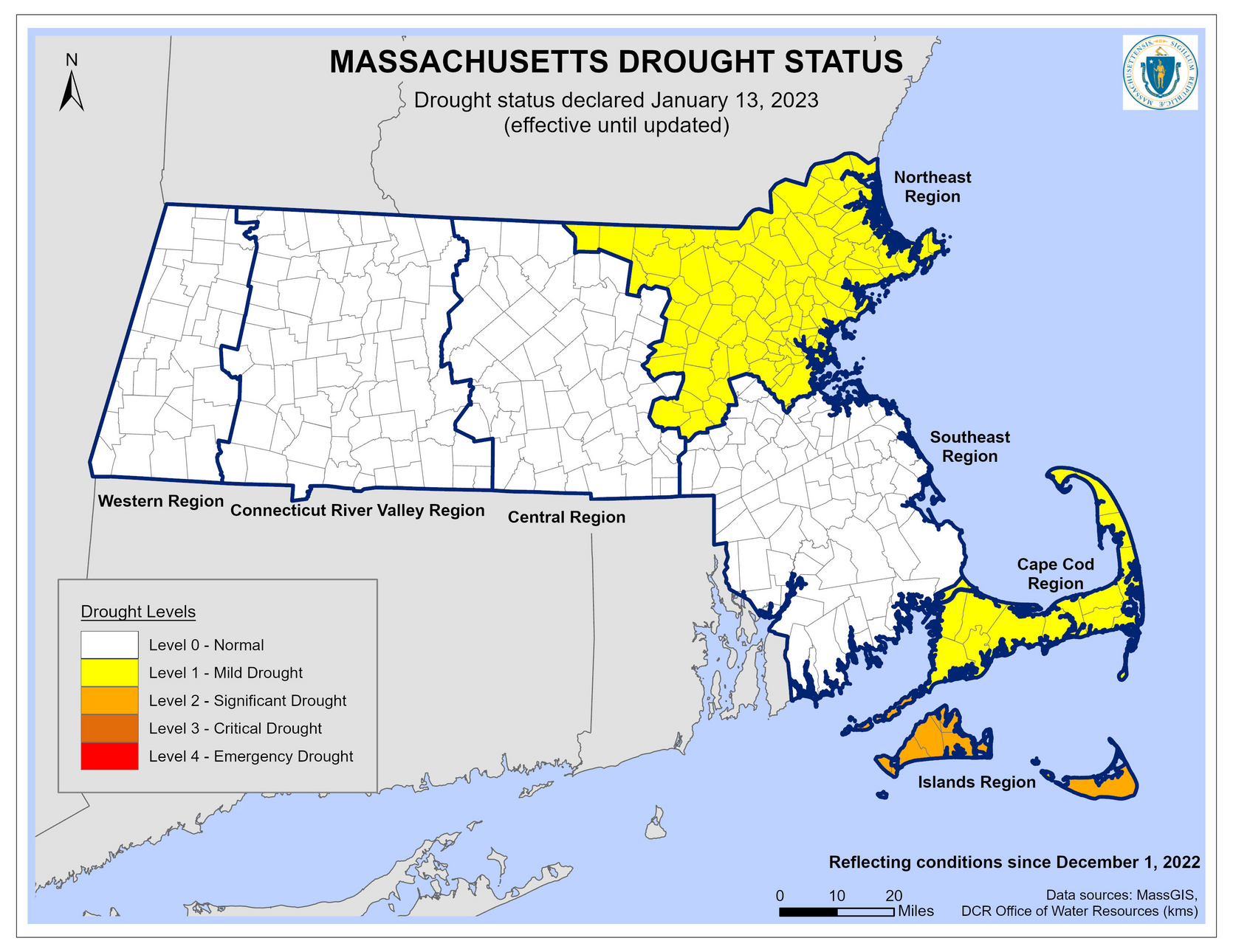- Drought Management Task Force
- Executive Office of Energy and Environmental Affairs
Media Contact
Troy Wall, Communications Director

BOSTON — Through the month of December 2022, the majority of the state experienced drought improvements, and as a result, Energy and Environmental Affairs (EEA) Secretary Rebecca Tepper today announced the following drought declarations: the Islands Region will remain at a Level 2-Significant Drought, the Northeast and Cape Cod Regions have been upgraded to a Level 1-Mild Drought, and the Connecticut River Valley Region will join the Western, Central, and Southeast Regions at Level 0-Normal Conditions. Rain and snow events during the previous month and a half have been well above normal, and conditions are expected to continue to improve through January 2023. However, for the state to be completely out of the drought, which is a longer-term condition, Massachusetts will need to benefit from sustained rainfall for a few more months before the entire state is within Normal conditions.
As outlined in the Massachusetts Drought Management Plan, a Level 1-Mild Drought warrants detailed monitoring of drought conditions, close coordination among state and federal agencies, and technical outreach and assistance to the affected municipalities. Additionally, a Level 2-Significant Drought calls for the convening of an interagency mission group to more closely coordinate on drought assessments, impacts, and responses within state government.
“While it is great to see significant improvements throughout Massachusetts, it is critical that everyone practices indoor water conservation methods, particularly those residing and working within the Islands, Northeast, and Cape Cod Regions of the state,” said Energy and Environmental Affairs Secretary Rebecca Tepper. “Through our ongoing collective efforts, water systems will return to normal and fully rebound faster, ensuring essential needs, such as for drinking water, fire suppression, and supporting habitats, will continue to be met.”
Today’s declarations are the result of recommendations made by the state’s Drought Management Task Force, which is composed of state and federal officials, and other entities. The taskforce will continue to meet until water levels return to normal in all affected regions of the state. The task force noted that it will take more time for the Commonwealth to come out of the longer-term drought, which started in early 2022, and has resulted in anywhere between two to ten inches of rainfall deficits over the course of the year in different regions of the state. Below are recommendations for communities and individuals living and working within a Level 2 – Significant Drought region and a Level 1 – Mild Drought region, including those utilizing a private well. Residents and businesses are also asked to check with their local water system in case more stringent watering restrictions are in place.
For Regions in Level 2 – Significant Drought
Residents and Businesses:
- Minimize overall water use; and,
- Follow local water use restrictions.
Immediate Steps for Communities:
- Limit washing of hard surfaces (sidewalks, patios, driveways, siding); personal vehicle or boat washing; and,
- Establish water-use reduction targets for all water users and identify top water users and conduct targeted outreach to help curb their use.
Short- and Medium-Term Steps for Communities:
- Establish a year-round water conservation program that includes public education and communication;
- Provide timely information to local residents and businesses;
- Implement or establish drought surcharge or seasonal water rates;
- Check emergency inter-connections for water supply; and,
- Develop or refine your local drought management plan using guidance outlined in the state Drought Management Plan.
For Region in Level 1 - Mild Drought
Residents and Businesses:
- Toilets, faucets, and showers are more than 60% of indoor use. Make sure yours are WaterSense efficient;
Short- and Medium-Term Steps for Communities:
- Establish a year-round water conservation program that includes public education and communication;
- Provide timely information to local residents and businesses;
- Check emergency inter-connections for water supply; and,
- Develop a local drought management plan.
Furthermore, the Massachusetts Department of Environmental Protection (MassDEP) will continue to provide technical assistance to communities on managing their water systems, including assistance on use of emergency connections and water supplies.
“The drought situation is still improving across the Commonwealth and today’s recommendation is based on conditions through December that do not consider the heavy, early precipitation we are experiencing this month,” said MassDEP Acting Commissioner Gary Moran. “This drought was the result of the long-term precipitation deficits that have built-up over many months, so it will take time to recover. We urge residents to follow the recommendations of their water supplier and continue to conserve water.”
It is important to note that the Massachusetts Water Resources Authority (MWRA) water supply system is not experiencing drought conditions, as defined within its individual plan. Private wells, local streams, wetlands, vernal pools, and other water-dependent habitats located within MWRA-serviced areas may be impacted by drought conditions, while water quality in ponds can deteriorate due to lowering of levels and stagnation.
The Drought Management Task Force will meet again on Wednesday, February 8, 2023, at 10:00AM. For further information on water conservation and what residents can do, please visit EEA’s Drought page and water conservation page. To get the most up-to-date information on the drought indices, go to the state’s drought dashboard webpage. Additionally, the Commonwealth is surveying the public for any drought impacts that are currently being experienced. To participate, please visit the Massachusetts Water Impact Reporter webpage.
###